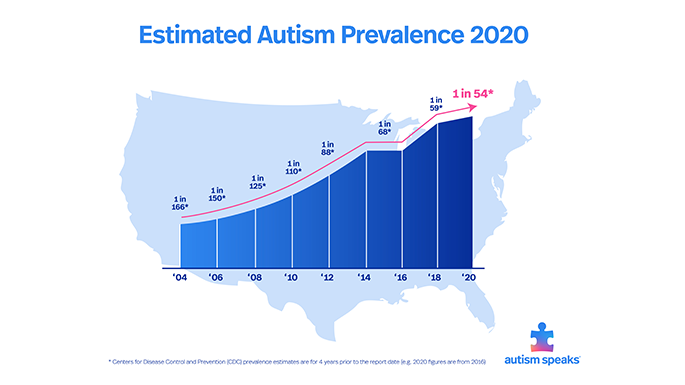CDC estimate on autism prevalence increases by nearly 10 percent, to 1 in 54 children in the U.S.
Important progress made in key indicators: For the first time, prevalence rates are the same for black and white children, and significant progress made toward number of children receiving developmental screening by age 3

NEW YORK (March 26, 2020) - The Centers for Disease Control and Prevention (CDC) released today its biennial update of autism’s estimated prevalence among the nation’s children, based on an analysis of 2016 medical and/or school records of 8-year-olds from 11 monitoring sites across the United States. The new report demonstrates real progress in early screening and diagnosis, the result of more than a decade of awareness and advocacy work by Autism Speaks and other organizations.
The report reflects a continued increase in the prevalence of autism spectrum disorder (ASD) in the United States. Importantly, for the first time the CDC found no difference in the prevalence rates between black and white children, indicating that gaps in access to screening and diagnosis may be closing.
“The world of autism has changed considerably since we were founded in 2005, when the estimated prevalence was 1 in 166,” said Autism Speaks President and Chief Executive Officer Angela Geiger. “Core to our mission since our founding has been to increase screening and lowering the age of diagnosis, especially in minority populations. This news could not be more rewarding to the thousands of Autism Speaks advocates, volunteers and community partners, as well as campaign partners Ad Council and BBDO whose award-winning work made this possible. It shows that when non-profits make an issue a priority, change happens.”
Key findings include:
- One in 54 children had a diagnosis of ASD by age 8 in 2016, a nearly 10 percent increase over 2014 when the estimate was 1 in 59.
- While the CDC found no difference in prevalence rates between black and white children, a gap remains in prevalence among Hispanic children, indicating a need to expand screening and intervention among this group. Further, black and Hispanic children identified with autism received evaluations at older ages than similar white children, again indicating that more needs to be done in this area.
- The number of children who had a developmental screening by age 3 increased from 74 percent to 84 percent, a sign of potential progress toward earlier and more consistent screening by healthcare providers.
- Boys are four times as likely to be diagnosed as girls, holding steady from previous reports. This indicates the need for more research to understand the gap in prevalence and ensure girls on the spectrum are receiving the care they need.
- Significant differences remain in the frequency of autism diagnosis between the CDC’s monitoring sites. These range from a low of 1 in 76 in Colorado to a high of 1 in 32 in New Jersey. This may be due to how autism is diagnosed and documented in different communities.
“We have worked tirelessly to fuel research that would allow earlier diagnosis and intervention; advocacy with and for the autism community to ensure access to care; and programs and services that allow our constituents to reach their full potential,” Geiger added. “Despite the progress made, we know that more is needed. We will continue to champion the importance of early screening and intervention for all children, as we know this leads to better outcomes and increases the opportunity for people with autism to thrive.”
Autism Speaks calls on legislators, public health agencies and the National Institutes of Health to advance research to better understand the continued increase in prevalence and the co-occurring medical conditions that may accompany autism. In doing so, the organization urges policy makers to double the federal funding of autism research, in accordance with the guidance of the Interagency Autism Coordinating Committee (IACC), and to advance policies that better provide services and supports for early intervention, education, transition to adulthood, employment and community living.
The CDC report was released in advance of April’s World Autism Month and World Autism Awareness Day (April 2), which Autism Speaks dedicates to increasing global understanding and acceptance of people with autism. To engage in this effort to create a kinder, more inclusive world, visit www.autismspeaks.org/kindness.
To join the conversation, find @autismspeaks on Facebook, Instagram and LinkedIn. For personalized support and questions, contact the Autism Response Team at 1-888-AUTISM2, en Español at 1-888-772-9050 or by email at help@autismspeaks.org.
About Autism
Autism, or autism spectrum disorder, refers to a broad range of conditions characterized by challenges with social skills, repetitive behaviors, speech and nonverbal communication. We know that there is not one autism but many subtypes, and each person with autism can have unique strengths and challenges. A combination of genetic and environmental factors influences the development of autism, and autism often is accompanied by medical issues such as GI disorders, seizures and sleep disturbances. Autism affects an estimated 1 in 54 children.
No comments:
Post a Comment